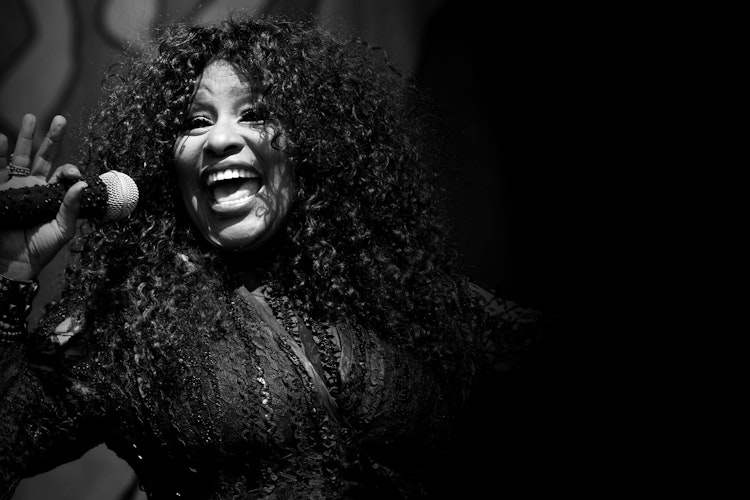In part 3 of this series, we will celebrate female artists and bands from multiple decades who were, and still are, influential in shaping music as we know it.
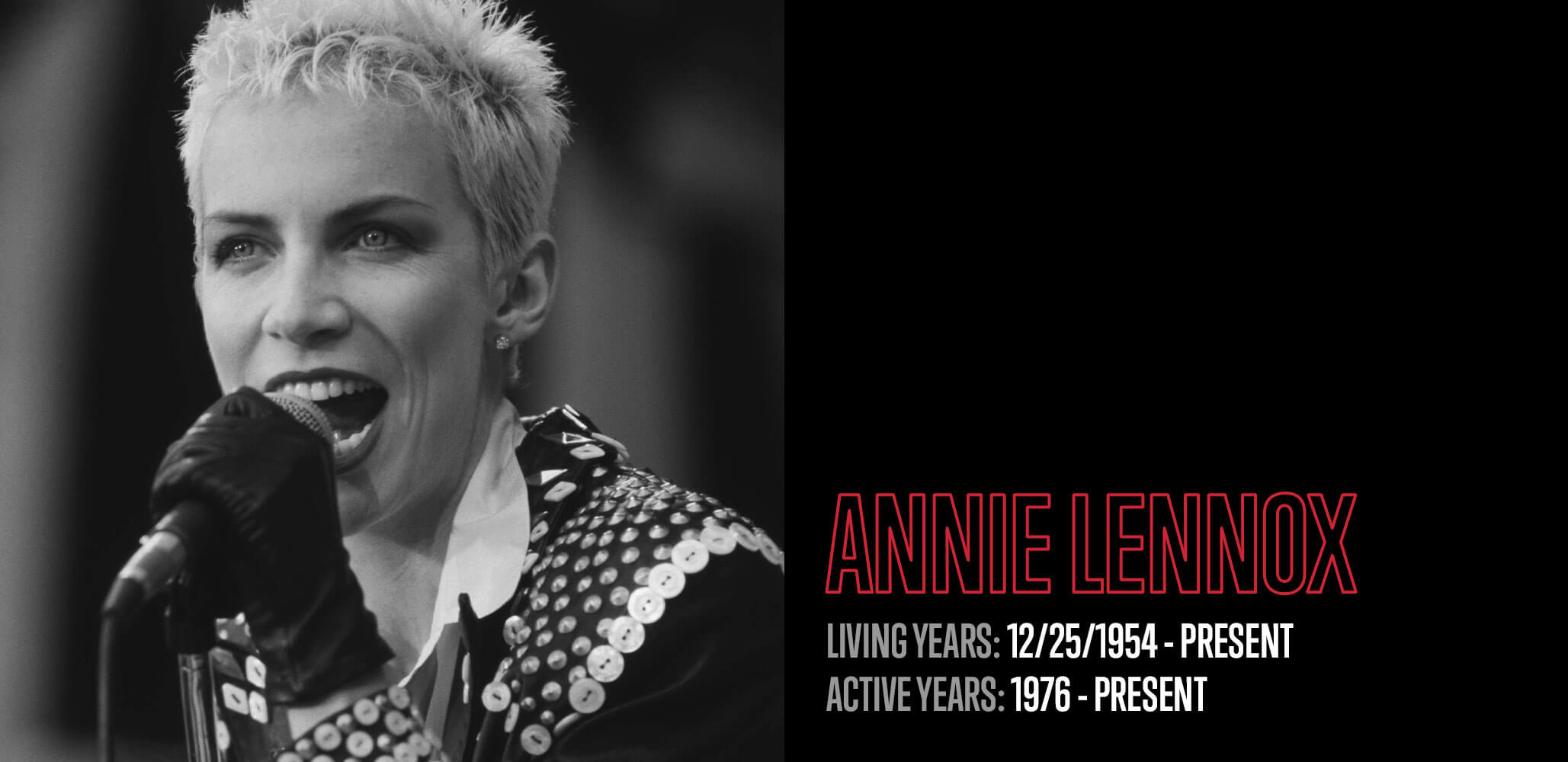
INSTRUMENTS
Voice, piano, flute
GENRES
Blue-eye Soul, Pop-Rock, Rock, Pop, New Wave, Synth-pop, Electronica, Soul, R&B, Jazz, Adult Contemporary
NOTABLE SONGS
Sweet Dreams (Are Made Of This), Here Comes The Rain Again, Who’s That Girl?, Would I Lie To You?, Missionary Man
BIOGRAPHY
Singer/songwriter Annie Lennox has sold over 80 million records, been awarded eight Brit Awards (more than any other female artist), four Grammys, a Golden Globe, and an Oscar. A compelling performer with a powerful stage presence, Annie has always seamlessly juxtaposed her articulate, soft-spoken, personable interview style with the ultra-flamboyance required to captivate large stadium audiences. It’s no wonder she has earned the distinction of Most Successful Female British Artist in UK history.
Ann Griselda Lennox was presented as an only child to her working-class family on Christmas Day, 1954 in Aberdeen, Scotland. From a young age she learned to play the flute and piano, then as a teen although she won a scholarship to the London Royal Academy of Music, she struggled with self-doubt and melancholia. This self-doubt eventually caused her to leave school to perpend which musical direction to take. Throughout the next few years, like so many musicians, she worked a variety of diverse day jobs including shop assistant and waitress, while singing and playing at night. She became well-known for her androgynous look and soulful voice. In the late 1970s, she joined a British Pop band called The Tourists, her first musical collaboration with guitarist and songwriter, Dave Stewart.
The Tourists had a modicum of success and even landed on the UK charts, but in 1980 when Annie and Dave decided to leave and form The Eurythmics, the duo’s careers began to ignite, crafting synth-pop hits with intelligent lyrics. In America, the band’s rise came during the age of MTV, and Annie visually stole the spotlight with her compelling on-screen presence that explored androgyny and femininity alike. By 1990, they had created a massive catalog of songs and were constantly touring, and Annie felt she lacked roots. That year, she decided to leave The Eurythmics to work with the homeless.
By 1992 Lennox returned to music with the release of her first solo album, Diva, which topped the UK charts at Number 1. She has released a total of 6 solo albums with vocals and one EP containing four improvised piano tracks to accompany her art installation at the Massachusetts Museum of Contemporary Art, titled: Now I Let You Go.
Throughout the years Annie has repeatedly referred to her desire to create great music that she enjoys and responds to, rather than be driven by chart success. As an artist who is deeply influenced by Bob Marley’s music and activism, she recognizes the power her position as a singer affords her, using it as a platform to advocate for social and political justice. An outspoken activist and thoughtful orator, Lennox has earned the Order of the British Empire [OBE] by the Queen, an award that recognizes extraordinary contributions to England.
Annie Lennox does not appear to be slowing down anytime soon. She currently lives in Los Angeles and during the COVID lockdown, she has been busy producing a record for her daughter, Lola Lennox. Annie’s last release was A Christmas Cornucopia, which included a recording of “Dido’s Lament”, an operatic aria written by Henry Purcell around 1688, which is remarkably poignant still. A quote from Annie appears at the beginning of the accompanying video:
“When it comes to climate catastrophe, we are on the edge of the abyss. I really don’t believe we have much time left to make an effective change. We are looking at a civilization on the downwards side. This is the truth of the matter. It’s staring us in the face and we are not paying any significant attention - continuing on as if it doesn’t exist. I see Dido’s Lament as a lament for our dying planet.” - Annie Lennox, December 2020
ARTISTS/ACTS THEY INFLUENCED
Adele, Taylor Swift, Amy Winehouse, Garbage
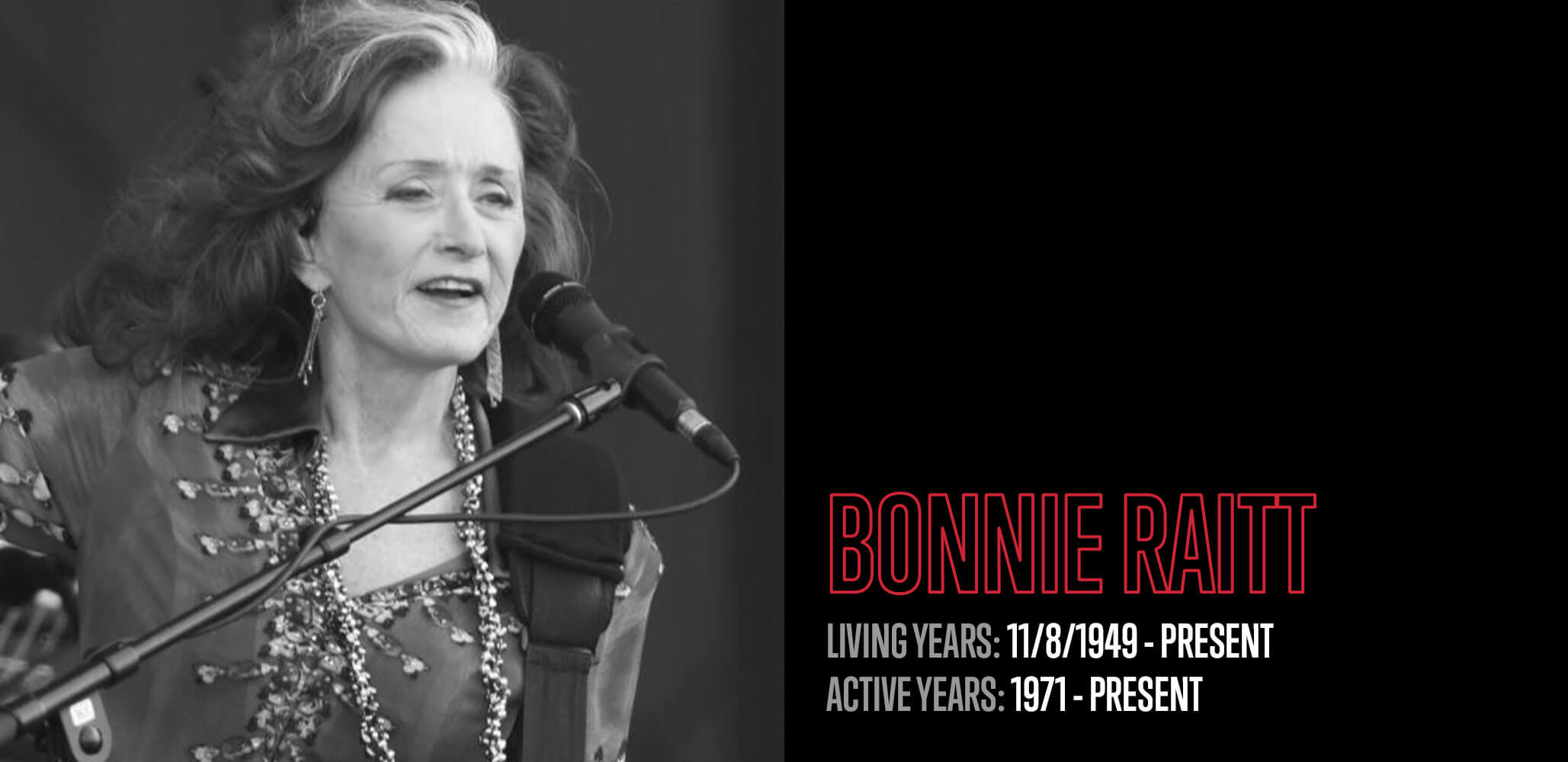
INSTRUMENTS
Vocals, guitar & piano
GENRES
Blues, Blues Rock, Roots Rock, Americana, Folk
NOTABLE SONGS
Something to Talk About, I Can’t Make You Love Me, Angel From Montgomery
BIOGRAPHY
Bonnie Raitt has had a career that has spanned almost five decades. She has received 10 Grammys and has been nominated for many more. As a young girl in California, Raitt was born into a musical family. Her mother was an accomplished pianist and her father was an acclaimed Broadway actor. They encouraged her and her two brothers to pursue music as well. She began performing in California and continued when she moved to Boston to attend college.
After gaining the attention of a writer at Newsweek, she signed her first major record deal in 1971. Her early records featured the songs of slide guitar masters such as Mississippi Fred McDowell and Robert Johnson. In 1974, she released Streetlights which included the John Prine penned classic “Angel From Montgomery”, her first hit song. The album also marked a departure from the Blues to other genres of Rock and Pop music.
Over the next decade, she had moderate success, but couldn’t quite break into the mainstream. She was immensely respected by her peers, but none of her albums had commercial success. Along with her passion for music, Raitt also has felt strongly about environmental change and clean energy. In 1979 she helped to organize a star-studded event at Madison Square Gardens for Musicians United for Safe Energy. Raitt’s big breakthrough came in 1989 when she released the album “Nick of Time”. It went to number 1 on the charts in 1990 and was ranked at #230 on Rolling Stones “500 Greatest Albums of All Time”. In 1990, she garnered 4 Grammy awards including Female Rock Vocal, Female Pop Vocal, and Album of the year. She also won Traditional Blues Album for her work with John Lee Hooker on the "In the Mood" record.
Raitt is perhaps the world’s most recognized female electric slide guitarist and was the first female guitarist to have her own signature model Fender guitar. Early in her career, she favored playing acoustic slide but adapted her style to playing a vintage Stratocaster with a glass slide. Raitt favors open A tuning and has a very lyrical style of playing which provides her a distinctive second voice as powerful and expressive as her vocals.
Bonnie Raitt has continued to write and record albums and remains active in the causes she feels so passionately about. She has been called one of the 100 greatest singers and guitarists of all time and she has earned that title over the span of her career. Raitt was inducted into the Rock and Roll Hall of Fame in 2000 and continues to record and tour.
ARTISTS/ACTS THEY INFLUENCED
Lucinda Williams, Joan Osborne, Sheryl Crow, Melissa Etheridge
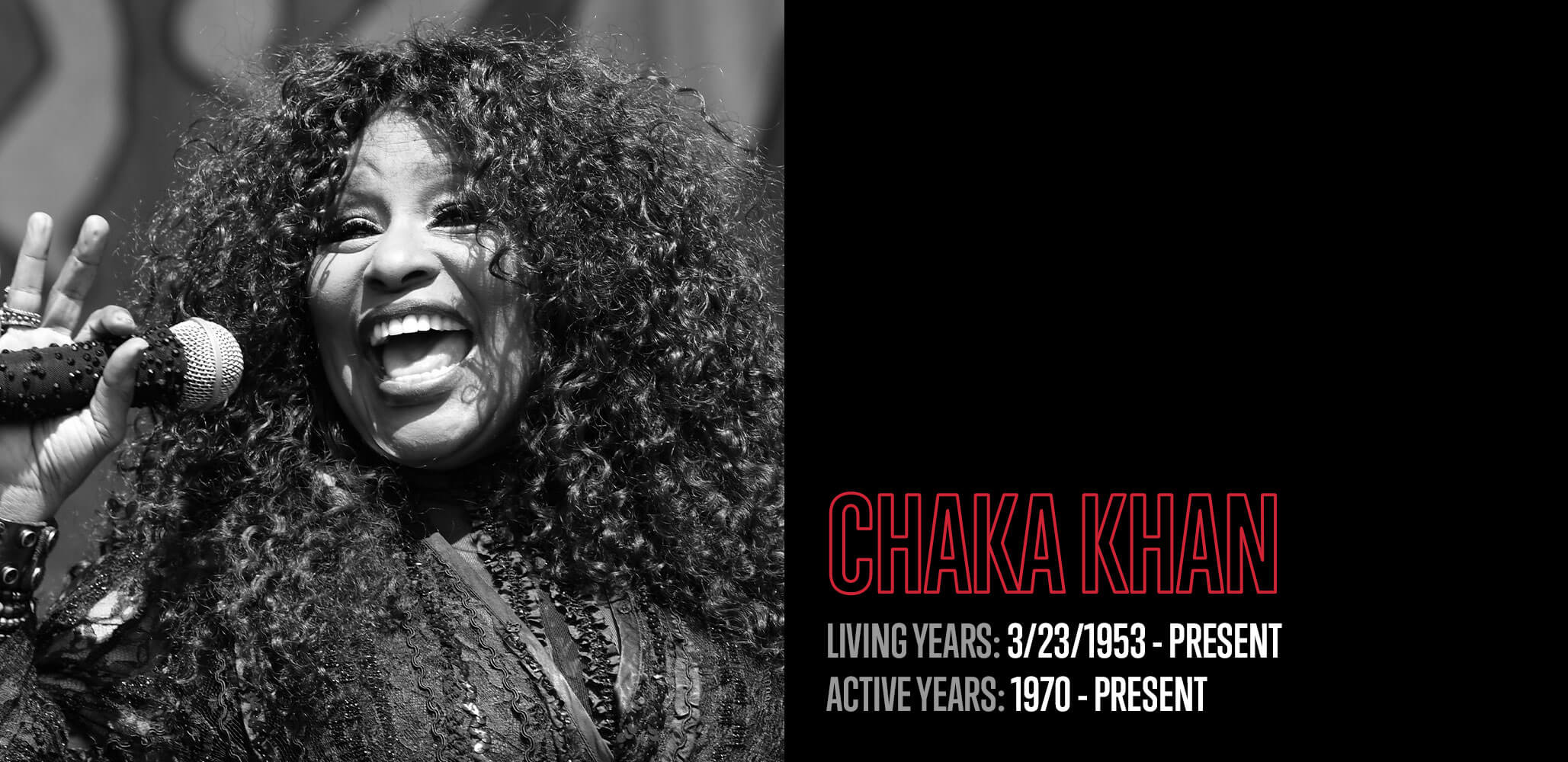
INSTRUMENTS
Voice
GENRES
Jazz, R&B, Gospel, Pop, Disco, Rock
NOTABLE SONGS
Tell Me Something Good, I’m Every Woman, Sweet Thing, I Feel For You, Through The Fire
BIOGRAPHY
10 time GRAMMY® Award Winner and 2021 Rock & Roll Hall of Fame nominee Chaka Khan was born March 23rd, 1953 as Yvette Marie Stevens, to a diversely artistic family of painters, musicians and singers in Naval Station Great Lakes, Illinois (Hyde Park). As a small child, she watched her parents craft fine murals of grand architecture on the interior walls of any apartment they lived in, and listened to jazz, gospel and R&B greats. Raised in the Catholic church, Chaka also sang opera and Gregorian chants in her early years, and by the tender age of 11 she had formed her first singing group with two friends and her sister Yvonne, called the Crystalettes. Supported by their mother with costumes and transportation, the Crystalettes consistently ranked 1st or 2nd in the local singing competitions. Although that group didn’t last, there is a musical working bond between Chaka and her talented siblings that continues to this day.
In high school, Chaka joined the Affro-Arts Theater and was briefly involved in the Black Panther movement, running a free Breakfast for Children program and adopting her new name of Chaka Adunne Aduffe Hodarhi Karifi. [Note: Although Chaka means fire in many African languages, in an VLadTV October 2020 interview, she explains that Chaka is the female form of the male name Tchaka, which means warrior. The female form of the name, Chaka, means warrioress.] Later, Chaka quit high school and moved in with her photographer father, Charles Stevens, where she began to meet, work with and befriend the musicians she grew up listening to and admired deeply, like Sarah Vaughn, Miles Davis and Dizzy Gillespie. Chaka felt as if she had arrived, and that at the time it was the biggest accomplishment of her life. She joined two different dance bands, Lyfe and The Babysitters, before meeting Rufus - the band which would launch her musical career. Chaka tells the story of hanging out at the communes on Rush Street and jamming at the clubs. She stumbled upon Rufus playing at a club and fell in love with the wall of sound they created live. Rufus was composed of ex-The American Breed members Andre Fischer and Kevin Murphy, who had a hit single in 1968 with “Bend Me Shape Me”. When Chaka met them, they played mostly original country music and she was excited to know musicians of their caliber. She became good friends with their lead singer, Pauline, and learned much about the business. After Rufus’ lead singer left, Chaka jumped in without missing a beat. What many people may not remember is that Chaka’s first album with Rufus was in the Country genre and although they were one of the most popular bands in Chicago, poor record sales inspired the band to push their musical boundaries. After they started touring with the Rolling Stones, their sound started expanding as Chaka’s multi-faceted voice easily sang from Opera to Rock, Country, Jazz, and Blues and her onstage presence grew as an activist, dawning Native American attire because she wanted to represent “a part of our collective history that we didn’t celebrate” as she is part Blackfoot Indian.
Rufus & Chaka Khan earned their first GRAMMY® Award with Rufus on “Tell Me Something Good”, a song credited to Stevie Wonder. Interestingly, in an interview Chaka states she co-wrote the song, but didn’t take any writing credits because she wasn’t aware of how writing credits worked and she was overwhelmed meeting Stevie Wonder. Rufus & Chaka Khan became a hit making machine and played to sold-out auditoriums and arenas across the country while the African-American members of the band endured racism at hotels, truck stops and restaurants. The band earned a number of gold and platinum albums before Chaka decided to go solo, in 1978.
Chaka’s solo career has produced a massive amount of hits and showcased her powerful, unique voice that has been more often compared to an instrument. As the late Jazz great Miles Davis used to say, “She sings like my horn”. Her voice is nearly uncategorizable, as she easily bends and sways into any genre as she does effortlessly on Rick Wakeman’s concept album, 1984. Ms. Khan has also expanded her creative endeavors into numerous acting roles, including starring in the Broadway production of The Color Purple.
In the Oct 2020 VLadTV interview, Chaka reminisced about meeting Robert Palmer in the mid 1980’s, and stated they fell in love listening to “The Night I Fell In Love, by Luther (Vandross)”. Palmer was about to record his soon-to-be hit song Addicted To Love and invited Chaka to the studio where she wrote vocal arrangements. Originally, they recorded the song as a duet, believing their record company couldn’t possibly object as Chaka worked for Warner Brothers, and Palmer for Island Records. But Warner wouldn’t grant a release for the duet version of the song. Ms. Khan stated in the interview that she believes that incident was the first time she experienced racism within the music industry. Although the world never was blessed to hear that duet, Palmer credits Chaka with the vocal arrangements in the album’s liner notes.
Chaka Khan is celebrating 40 years in the music industry, with a total of 22 albums to her name, 10 of which went gold or platinum and a song catalog over 2,000. Ten of her songs have gone to #1 on the Billboard Magazine chart. Chaka Khan is a powerhouse of a performer who has carved her name into music history.
TECHNICAL INNOVATIONS
I Feel For You - her smash hit cover of Prince’s song, was one of the first songs to combine Rap and R&B.
ARTISTS/ACTS THEY INFLUENCED
Whitney Houston. Whitney did her first recording at the age of 14, with her mother, Cissy Houston, on one of Chaka’s songs. Cissy was already one of Chaka’s main backup vocalists.

INSTRUMENTS
Vocals, guitar, piano, dulcimer
GENRES
Folk, Rock, Jazz, Pop
NOTABLE SONGS
Big Yellow Taxi, Both Sides Now, California, Carey
BIOGRAPHY
Joni Mitchell is a Canadian singer-songwriter whose influence resonates throughout many of the most successful musicians of the 20th and 21st centuries. Though she is celebrated as a 60s Folk darling, her music career was endlessly inventive and she experimented with Pop, Rock, Classical, Jazz, World Music, and Electronic Music at different periods in her life. Her lyrics examine social and philosophical constructs while also exploring joy, heartbreak, and experiences as a woman; Rolling Stone summarized her as simply “one of the greatest songwriters ever”.
She was born Roberta Joan Anderson in Fort McLeod, Alberta, Canada, on November 7 of 1943. Her family relocated several times but she considers Saskatoon, Saskatchewan, her hometown. She suffered from polio at the age of nine and has stated that the grim experience and recovery influenced her sense of inner self and ignited her interest in art and expression. She took up visual art when she was young and has remained a painter her whole life, and designed and painted most of her own album covers.
Mitchell taught herself the ukulele and then guitar from a Pete Seeger songbook. She devised alternative tunings to her guitar to compensate for her polio-weakened left hand. In time, she would become known for her “weird Joni chords” and this became part of her distinctive sound and songwriting structure. Her first paid gig was at the Louis Riel coffeehouse in Saskatoon, Saskatchewan.
Mitchell moved to Alberta to attend art school and played gigs on the weekend, taking a job at a place called The Depression Coffee House. At 20, she quit school and moved to Toronto to be a Folk singer. After struggling to make ends meet with small gigs and retail jobs, American Folk singer Chuck Mitchell was impressed by her original material and invited her to move to the United States. The two moved to Detroit and began playing music together, marrying in 1965. She began playing and composing her own songs using unique and alternative guitar tunings, garnering her signature sound. She moved to New York City in 1967 to play as a solo artist. Her songwriting and innovative guitar style became well-known.
She caught the attention of ex-Byrds member David Crosby, who helped her network in Los Angeles where she was signed to the Reprise label. She released her debut album, Song to a Seagull, in 1968 and toured extensively to promote it. Meanwhile, her songs were being covered by other performers, giving her more clout as a major songwriter. Judy Collins’ cover of Joni’s song, “Both Sides Now”, cracked the top 10 Billboard charts, creating buildup for Joni’s Grammy-winning second album entitled Clouds with her own versions of already popular songs including “Both Sides Now”, “Chelsea Morning”, and “Tin Angel”. Soon after she released Ladies of the Canyon which was an instant hit and became her first gold album.
Feeling drained from touring and performing, she took a year off and traveled through Europe, inspiring songs like “Carey” and “California” for her next album. Blue was released in 1971 to instant success, peaking in the top 20 charts in September. For these songs, Mitchell intentionally moved away from the style of her earlier records and wanted Blue to represent herself as an emotionally vulnerable artist, and not just an image. Audiences were struck by this, and the album was rated the 30th best album ever made in Rolling Stone’s 2003 list.
Mitchell is unique in the way she explored different musical influences and collaborations over the years, forever pursuing her art. Jazz and Pop sounds came through in albums such as Court and Spark (1974) and evolved into less structured Jazz and World pieces such as Hejira (1976), the latter of which incorporated Jazz fusion giants like Jaco Pastorious and Herbie Hancock. After this release, Mitchell was contacted by the famous Charles Mingus to collaborate. Sadly, he died before the project was completed; she finished the tracks and released it under the name “Mingus” in 1979.
In the 80s Mitchell made a return to Pop songwriting, complete with Synthpop production, with albums Wild Things Run Fast and Night Ride Home. Mitchell’s next Grammy-winning record came with the 1994 release of Turbulent Indigo, an album that many fans felt was a return to her original style. Her 2002 album Travelogue was stated to be her final album at the time, but she released an album called Shine in 2007. She stated that the album was inspired by her grandson’s musings on the war in Iraq, and focuses on political and environmental issues.
Joni Mitchell’s intimate and multidimensional approach to music had a profound influence over female listeners and artists—an influence that spans decades. Mitchell asserted her artistic control through her entire career, producing her albums and pushing herself creatively rather than for commercial benefits. Artists such as Pink Floyd’s David Gilmour, Madonna, Lorde, Harry Styles, and Taylor Swift all cite her as an inspiration.
Mitchell was inducted into the Canadian Music Hall of Fame in 1981, received the Governor General’s Performing Arts Award for Lifetime Artistic Achievement in 1996, and received a star on Canada’s Walk of Fame in 2000. She’s only the third popular Canadian singer-songwriter (alongside Gordon Lightfoot and Leonard Cohen) to be a Companion of the Order of Canada. In 2007, she was inducted into the Canadian Songwriters Hall of Fame and the Saskatchewan Recording Industry Association presented her with their Lifetime Achievement Award in 1993. In 2018, the city of Saskatoon honored Joni Mitchell by constructing two plaques to recognize her musical roots in the first places she ever performed.
She’s received 9 Grammy Awards throughout her career, including a Grammy Lifetime Achievement in 2002, which described her as “one of the most important female recording artists of the rock era”. She received Billboard’s Century Award in 1995, the Polar Music Prize in 1996, and was inducted into the Rock and Roll Hall of Fame in 1997. In 2015 she was awarded the SFJAZZ Lifetime Achievement Award in San Francisco. In 2020, Mitchell was the first woman to receive the Les Paul award.
TECHNICAL INNOVATIONS
She played a custom guitar on her 1998 album “Taming the Tiger”: the instrument was equipped with a Roland hexaphonic pickup, which connected to a modeling processor. This let her play her alternate tunings without re-tuning the guitar from scratch each time because her guitar was transposed into the correct key in real-time.
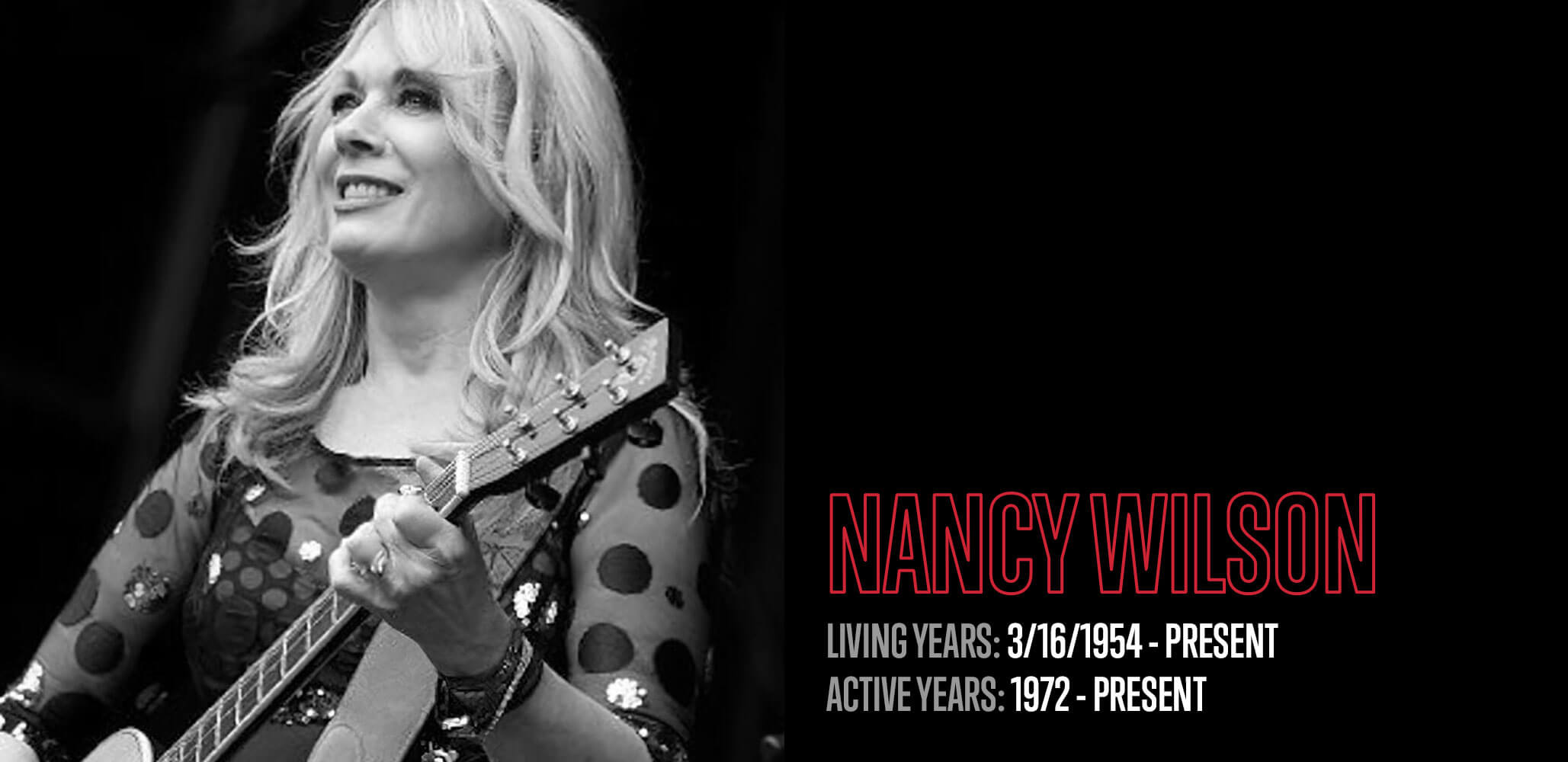
INSTRUMENTS
Guitar, vocals, autoharp, mandolin
GENRES
Hard Rock, Folk Rock
NOTABLE SONGS
Crazy On You, Magic Man, Barracuda, These Dreams
BIOGRAPHY
In the early 1970s, it was highly unusual to see a woman fronting a hard rock band. It was even more unheard of for a woman to play guitar, but Nancy Wilson was the exception. Gibson ranked her as the eighth greatest female guitarist of all time and she was inducted into the Rock and Roll Hall of Fame in 2013 with her band Heart. Nancy and her sister Ann are credited as being the first women to front a Hard Rock band and inspired women everywhere to claim their place, pick up a guitar, and start rocking.
Nancy Wilson was raised in Bellevue, Washington, a suburb of Seattle, by a very musical family. Nancy recalls her parents, aunts, and uncles, and grandparents singing and playing old Irish pub songs and even Vaudeville songs from the 20s on ukulele or piano at family get-togethers from a young age. However, it wasn’t until February 9, 1964, when the Ed Sullivan show hosted The Beatles as their musical guest that Nancy and Ann felt the spark. From that moment on, the sisters made it their mission to be rockstars.
Nancy was a gifted guitarist from the young age of 10 and throughout the years developed a style of playing that blends Flamenco and Classical guitar playing with Hard Rock. In college, Nancy played small acoustic shows performing covers of songs by Joni Mitchell and Paul Simon until her sister Ann joined a band called White Heart. Ann pressed Nancy to relocate to Vancouver where the band was based and join White Heart, but the other members were hesitant to allow it. After all, having a female lead vocalist in a Hard Rock band was already uncommon, but the members worried that having a female guitarist would cause the public to disregard them. By age 20, after sitting in on rehearsals and having an audition, Nancy claimed her spot in the group. The band recorded their first album Dreamboat Annie under the name Heart with Mushroom Records and released the single (Magic Man). The song was played throughout Vancouver and the surrounding areas until the album was released in the US in 1976. (Crazy on You), another song from the album which features Nancy’s acoustic guitar playing was written by the Wilson sisters and remains one of the band’s signature songs.
In the first 4 years, Heart released 3 more studio albums; Little Queen, Magazine, and Dog and Butterfly. Nancy was primarily tasked with the role of acoustic guitarist on these albums while also playing some electric guitar along with other instruments such as the autoharp, mandolin, and lead vocals on a few tracks. In October 1979, tension between Nancy and the lead guitarist of the band, Roger Fisher, led to Fisher’s departure from the band and Nancy gained the opportunity to play more electric guitar. Her electric playing can be heard on the songs (Even it Up), (What About Love), and (These Dreams). The latter of which she also took the role of lead vocalist. Heart has sold over 35 million records worldwide, has released 16 albums (seven top-10 albums), and had 20 top-forty singles.
Outside of Heart, Nancy Wilson is also an accomplished film composer. Her credits include scores for the films Almost Famous, Say Anything…, Vanilla Sky, Jerry Maguire (for which she was awarded the ASCAP award), and Elizabethtown. Nancy has stated that she used her experience as a performing musician to help create emotional connections with her audiences through her music in film.
Nancy Wilson’s four-decade-spanning career helped to define what it is to be a Rock musician, and specifically what it is to be a woman in the industry. She has been nominated for 4 Grammys, multiple awards from various film societies, and has been inducted into the Rock and Roll Hall of Fame. At a time where female musicians were underestimated and scarce, Nancy fought stereotypes to demand space and continues to do so today.
ARTISTS/ACTS THEY INFLUENCED
Lzzy Hale (Halestorm), Guns N’ Roses, The Go Go’s, Sheryl Crow, Girlschool
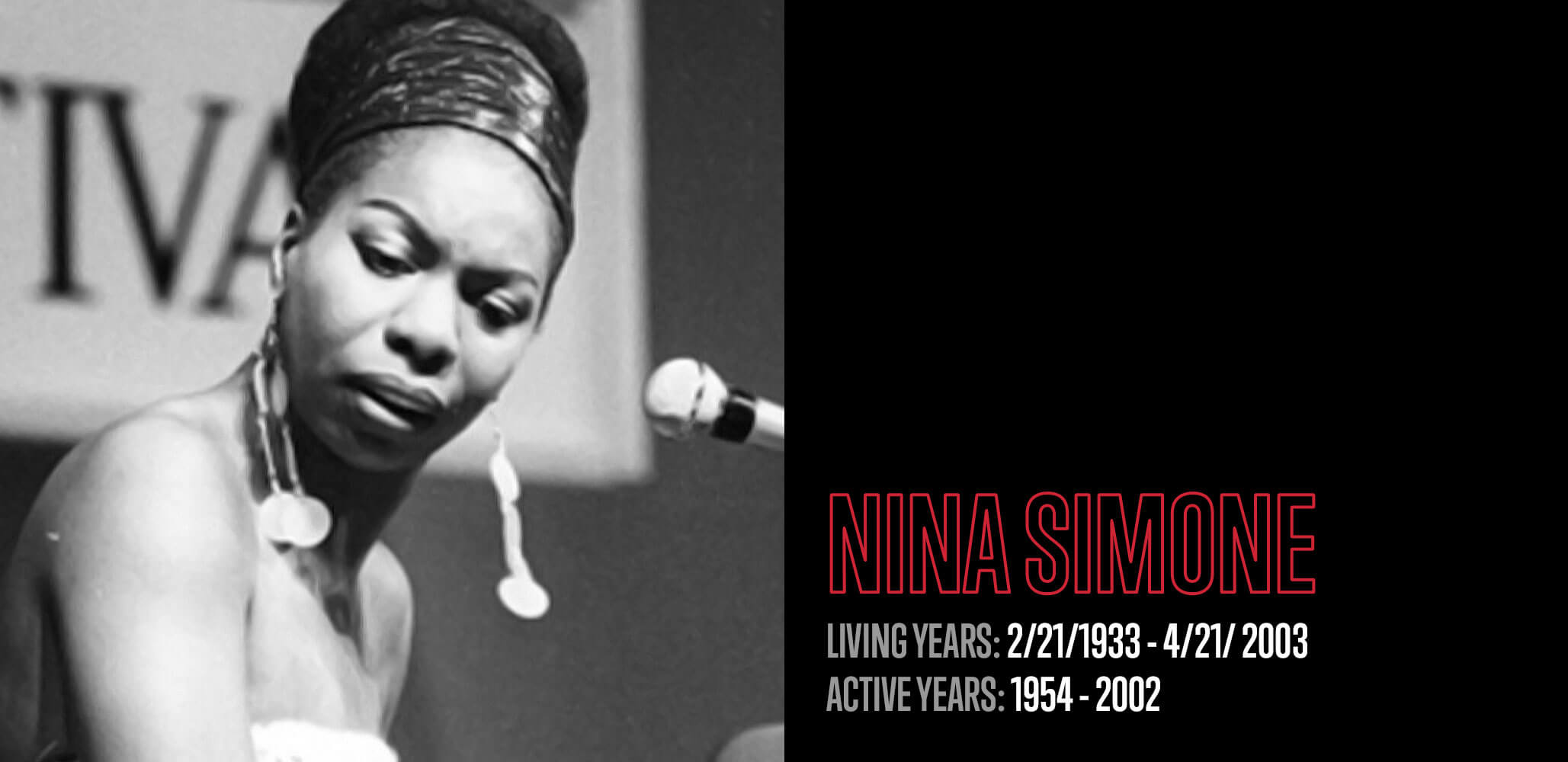
INSTRUMENTS
Piano and vocals
GENRES
Jazz, Blues, Folk, Classical, Gospel, Pop, R&B, Soul
NOTABLE SONGS
Mississippi Goddam, Feeling Good, I Loves You Porgy, Backlash Blues
BIOGRAPHY
Eunice Kathleen Waymon was born in the small mountain town of Tyron, North Carolina February 21st, 1933 becoming the sixth of what would be an eight-child family to Reverend John Devan Waymon and minister Mary Kate Waymon. Around the age of three or four, Eunice began playing piano, eventually leading her to play at the local church. Her first public performance was a Classical recital at the age of 12; even this very first performance was a sign of the artist to be as at the top of the show her parents were escorted from the front row to the back of the theatre to allow white people access to the front row. Eunice refused to play until her parents were allowed to reclaim their seats in the front row.
Seeing as her family was quite poor, Waymon’s music teacher set up a fund to assist paying for her education. With this generous scholarship funding, she attended Allen High School for Girls in Asheville, North Carolina. In the summer of 1950, Eunice studied with Carl Friedberg at the Juilliard School to prepare for her audition at the Curtis Institute of Music in Philadelphia. In anticipation of her acceptance, Eunice’s entire family relocated to Philadelphia, but her application was then denied with only 3 of the 72 applicants being accepted that year. Eunice then began taking private piano lessons with a professor at Curtis, Vladimir Sokoloff, and took jobs as a photographer’s assistant, as an accompanist for a local vocal studio, as well as taught private piano lessons at her home in Philadelphia.
To continue paying for her personal private lessons, Eunice began performing regularly at a venue on Pacific Avenue in Atlantic City, New Jersey. The owner of this club encouraged Eunice to sing in addition to playing piano and increased her income to $90 a week. In 1954 Eunice finally adopted her famed stage name “Nina Simone”, taking Nina from a pet name from her boyfriend at the time and Simone from a french actress she admired. Nina’s combination of Jazz, Blues, and Classical music in her performances garnered her a loyal yet small fan base.
As a favor to a friend, Nina recorded George Gershwin’s (I Loves You Porgy) which subsequently became her only Billboard top 20 success in the US. The following year in 1959 she released her debut album Little Girl Blue on Bethlehem Records, but selling her rights outright for $3,000 was quite the mistake for this initial record as she lost out on more than $1 million in royalties over time. Little Girl Blue was a success, and Simone was thrilled to sign a contract with Colpix records with the agreement that all creative control would be relinquished to her, including the type of material that would be recorded. With this record contract, Nina recorded a variety of both studio and live albums while she subsequently became a favorite performer in the New York City neighborhood Greenwich Village.
In 1964 Nina decided to make the move from distribution of her records through Colpix to the Dutch-based Philips Records, which allowed even more creative allowance in the content of her songs. Her debut album on Philips Records Nina Simone In Concert was released in 1964 and included her masterpiece (Mississippi Goddam) - her first civil rights song of many and compositions she wrote in less than an hour after hearing the news of the bombing at the 16th Street Baptist Church in Birmingham, Alabama which resulted in the death of four young black girls. From that moment on Nina fully embraced the civil rights movement and used her platform as a popular recording artist to speak at civil rights marches and meetings, such as the Selma to Montgomery march. In 1967 she made another move from Philips Records to RCA Victor where she would release another nine records through the seventies and eighties, including Nina Simone Sings The Blues. Through the course of the next two decades, Nina lived in a variety of places throughout the world - first moving to Barbados and then to Liberia, London, the Netherlands, and finally in Southern France all while she continued to write, record, and perform. During her final years, she quietly suffered from breast cancer, passing away in her sleep at her home in France on April 21st, 2003.
With her impressive career including 33 albums released in her lifetime, 21 of them being studio records, Nina inspired and continues to inspire generations of musicians, songwriters, singers, and performers alike, earning the title “The High Priestess of Soul”. Considered one of the most influential recording artists of the 20th century, Nina was a pioneer who broke the mold of not only what was expected of female musicians, but of black musicians as well, producing music and lyrical content that delivered direct social commentary. Nina received the Grammy Hall of Fame Award in 2000, two honorary degrees in music and humanities from Amherst College and Malcolm X College, four career Grammy Award Nominations, was inducted into the Rock and Roll Hall of Fame in 2018, and her song “Mississippi Goddam “was selected by the Library of Congress for preservation in the National Recording Registry in 2019.
TECHNICAL INNOVATIONS
Three-part counterpoint (two hands on the piano and her voice) each playing a separate but complementary melody line.
ARTISTS/ACTS THEY INFLUENCED
Elton John, Aretha Franklin, David Bowie, Adele, Janis Joplin, Peter Gabriel, Jeff Buckley, Madonna, Nick Cave, Hozier, & many more

INSTRUMENTS
Vocals, guitar, saxophone, piano, autoharp
GENRES
Indie, Rock, Blues, Goth, Folk
NOTABLE SONGS
Down By the Water, This Is Love, Sheela Na Gig
BIOGRAPHY
Polly Jean Harvey, better known as PJ Harvey, is one of the most distinctive artists in Rock music. Born in 1969 in Bridport, Dorsett England, Harvey grew up in a musical household exposed to her parent’s eclectic record collection. She took folk guitar lessons as a teen and picked up saxophone as well, joining a local instrumental ensemble. In 1988, Harvey began playing in a group called Automatic Dlamini which toured Europe. She contributed saxophone, guitar, and some vocals and started writing material for the band.
Two years later she decided to break off and pursue her own material. With two members of Automatic Dlamini, Rob Ellis (drums) and Ian Oliver (bass), she formed a trio under the name PJ Harvey. However, Oliver returned to Automatic Dlamini and was replaced by Steve Vaughan. With a band in place, Harvey was now the vocalist and guitarist. After an inauspicious start, the band relocated from Bristol to London where she hoped to also study Art. There they soon drew the attention of Too Pure Records who released the band’s debut 7” single “Dress”. “Dress” soon got the attention of influential BBC Radio 1 DJ John Peel who quickly invited the band to record a live BBC session (the first of many). A second single “Shela Na Gig” was released just weeks after the initial single and a full-length record Dry was released in 1991.
Dry received a fantastic critical reception both in England and the US with Rolling Stone magazine naming Harvey the Songwriter of the Year and Best New Female Singer. Kurt Cobain cited the record as one of his favorites and a special edition was released that also contained the demo versions of the songs. As Grunge was exploding, PJ Harvey was suddenly a buzz band and as such, the major label feeding frenzy resulted in a deal with Island Records. Rid of Me, recorded by Steve Albini (Nirvana’s In Utero) marked an evolution of PJ Harvey’s sound with elements of Grunge, Blues, and Goth. As the band received more attention, it became clear that while PJ may have started as a band, it was the vision and art of Polly Jean Harvey.
At this point, PJ Harvey was now billed as a solo act, even when backed by other musicians. The backing band consisted of John Parish (former bandmate in Automatic Dlamini), multi-instrumentalist Mick Harvey (of Nick Cave and the Bad Seeds), and drummer Jean-Marc Butty. Her next album Bring You My Love garnered a minor radio hit with “Down By the Water” and the album was commercially successful. It was named 1995’s album of the year by the New York Times as well as USA Today, and Rolling Stone who also named PJ Harvey Artist of the Year. While Down By the Water continued to showcase Harvey’s potent mix of alternative Rock, Goth, and Blues, her next album “Is This Desire?” marked a new direction with its use of Electronica elements.
2000 saw the release of Stories From the City, Stories from the Sea which featured a hit single “This Is Love”. The album was nominated for a Grammy for Album of the Year and “This Is Love” was nominated for Best Female Rock Performance. The album also featured Radiohead’s Thom Yorke on three tracks. Not content to play it safe, 2004’s Uh Huh Her featured Harvey on all instruments except drums, and the follow-up album White Chalk was piano-based. Let England Shake and The Hope Six Demolition Project featured songs that dealt with political themes, both domestic and internationally.
Not content to stick to one style of music, PJ Harvey is also active as an actress and visual artist. Outside of her own albums, she has famously collaborated with Nick Cave and she composed music for the Broadway production of Henrik Ibsen’s Hedda Garber. Harvey has also had great success releasing her own demos of her compositions that later appeared on the group’s albums. Not one to shy away from dark subject matter and taboo themes, PJ Harvey has always presented bold artistic statements in her own distinctive style.
ARTISTS/ACTS THEY INFLUENCED
Kurt Cobain, Nick Cave, Amanda Palmer, KT Tunstall
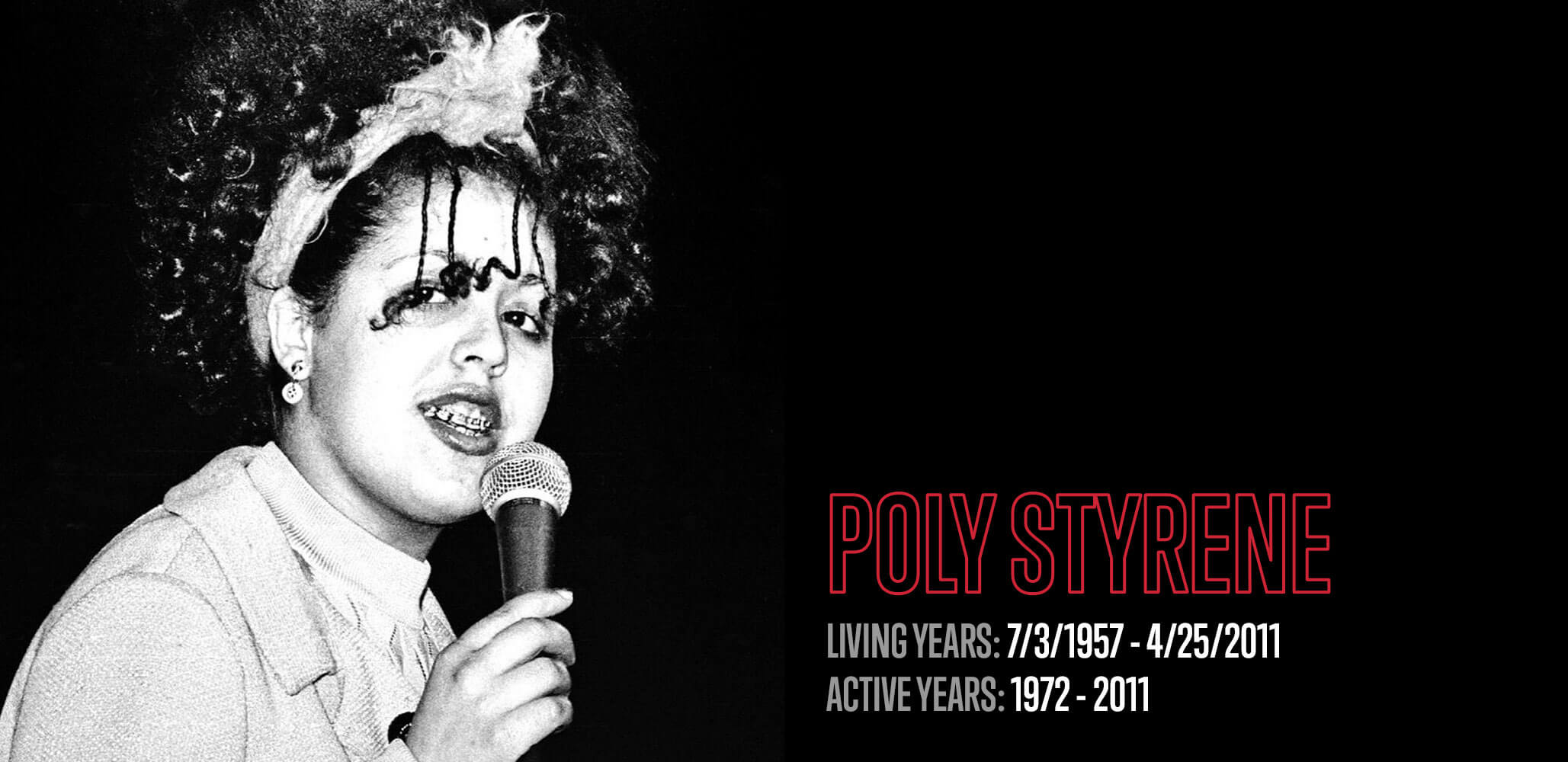
INSTRUMENTS
Voice, fashion, art
GENRES
Punk, New Age
NOTABLE SONGS
Oh Bondage Up Yours, Day the World Turned Day-Glo, Identity
BIOGRAPHY
If there is a woman who encapsulated the gaudy, nonconformity that is known as the Rock genre called Punk, it was Marianne Joan Elliott-Said. Bursting with artistic vision, sci-fi smart lyrics, brilliant handmade fashion, and an attitude culled from the countervailing creativity of the time, we know her as Poly Styrene, the founder and frontwoman for the band X-Ray Spex. A seemingly stark, small figure in a shiny boxy dress with a colorful plume from a hat barely hanging onto short black ringlets, walked to the microphone in 1977 England and opened a mouth full of thick braces: “Some people think little girls should be seen and not heard. But I think, OH BONDAGE UP YOURS!”. A full catapulting roar erupted from her vocal depths inciting social critiques on dystopian futures, capitalism, and the roles of women. Born in suburban Kent on July 3, 1957, but raised in ‘mixed’ Brixton, England, Poly’s astute observation was cultivated by a part Scottish-Irish, half-Somali heritage in working-class London.
Beginning with a love of Reggae, Styrene recorded her first demo, a Ska-ish single, “Silly Billy”, in 1975. In 1976 it was released under Mari Elliott, and on her 19th birthday that year, she saw the Sex Pistols and promptly took out an inspired ad in the newspaper seeking to form the punk band that would become the X-Ray Spex. The original lineup was Poly Styrene on vocals, Jak Airport (Jack Stafford) on guitar, Paul Dean on bass, Paul “B. P.” Hurding on drums, and Lora Logic (Susan Whitby) on saxophone. After a brief stint Logic left and was replaced by Steve “Rudi” Thompson, and though using a saxophone deviated from the other punk line-ups of the day it paired well with the unexpected power of Poly’s discordant voice and became their trademark sound. She steered this ship, branding herself and her band in refreshing Day-Glo in response to the brooding, dark-clad Punks. Always the dreamer, she wrestled with Punk’s cynicism and being a black, female artist and self-proclaimed anti-sex-symbol. The X-Ray Spex’s meteor flashed hot and bright for 3 years and left us wanting more by only releasing five singles-- "Oh Bondage Up Yours!", "Identity", "The Day the World Turned Day-Glo", "Germfree Adolescents", and "Highly Inflammable"—and one studio album, Germfree Adolescents.
They played the iconic Roxy theater twice in its early days, and it was there in 1977 during only their second live performance that “Oh Bondage Up Yours!” was captured on video, and then later put out on a 45. This was all the public momentum they needed to infect their growing Punk Rock community (Johnny Rotten, Siouxsie Sioux, Billy Idol, Chrissie Hynde, and more). Driving ahead, X-Ray Spex were invited to perform a number of high profile festivals (Front Row Festival 1977, Rock Against Racism 1978) that were later produced on vinyl, recorded with greats in the studio (John Peel at BBC Radio 1), and were featured in several rockumentaries (Who is Poly Styrene? 1979, DOA 1980). They released their debut, Germfree Adolescents, in November 1978 in the UK (not til 1992 in the US), with a brazen anti-consumerist theme that carried through on their spotty reunions in the following decades (Obsessed With You 1991, Live At The Roxy Club 1991, Live @ The Roundhouse London 2008). They released only one more full-length album, Conscious Consumer, in 1995 with the line-up of Styrene, Dean, and Logic.
Though ‘Marion’ dropped out of school at age 15 to run toward her future, she brought inner turmoil with her. “Identity is the crisis, can’t you see,” she screamed and agonized through waves of mental health problems throughout her life. After a particularly illuminating gig in 1978, Poly was hospitalized and misdiagnosed with schizophrenia, an impediment that wasn’t corrected until 1991 as bipolar disorder. Exhausted, she churned through the Spex’s only full UK tour and left the band by mid-1979. She could never be sure if she was swimming in madness or spiritual awakening so she became an ardent Hare Krishna devotee in the early 1980s, and during the decade gave birth to her first solo album Translucence 1980, a Synth-Pop 7 inch record “Talk In Toytown”, an EP Gods and Goddesses 1986, and to a daughter, Celeste Bell. She remained inspired by music, supported by feminist movements, artistically innovative, and awed by other musicians (collaborated on Goldblade's "City of Christmas Ghosts" 2008, Rock Against Racism 2008, and "Black Christmas" with her daughter 2010), releasing her second ‘New Age album in 2004, Flower Aeroplane. Over the years, Styrene was determined to continuously re-package herself with a sense of purpose and meaning but she remains an undisputed voice of a generation.
At 53 years old, Poly Styrene launched a new website and video of the first single, "Virtual Boyfriend", from her record Generation Indigo in March 2011. This final album was released in the US on April 24th, 2011, the day before she died in her sleep from breast cancer. Posthumously her daughter Celeste Bell has continued to produce shows featuring Poly’s archived multi-media art and co-wrote (Zoe Howe) a biography, Dayglo!: The Poly Styrene Story.
ARTISTS/ACTS THEY INFLUENCED
Sex Pistols, The Slits, Siouxsie & the Banshees, Generation X, Bikini Kill, Everything But The Girl, U2, Boy George, The Pretenders
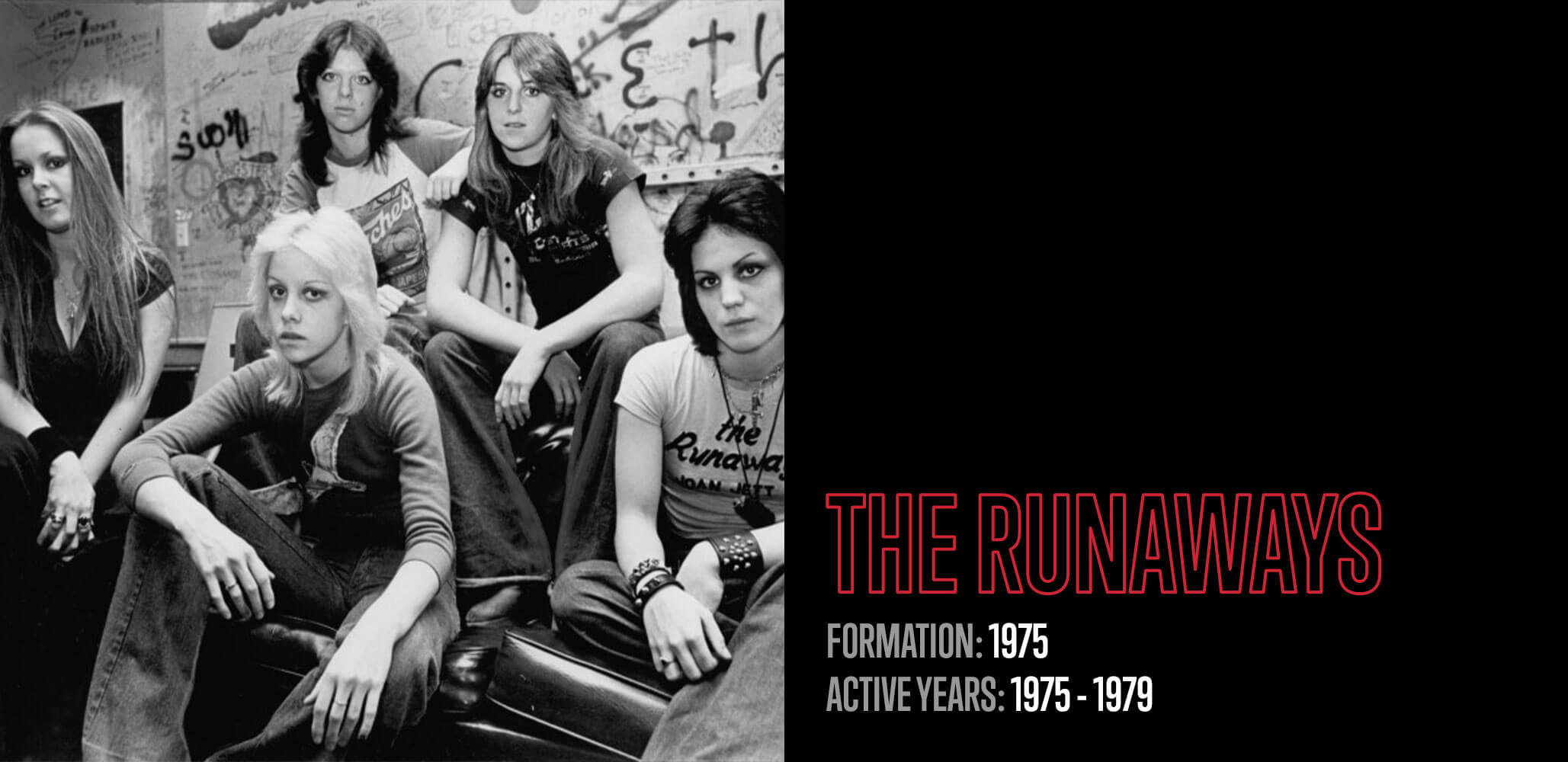
MEMBERS
Sandy West, Joan Jett, Micki Steele, Lita Ford, Peggy Foster, Cherie Currie, Jackie Fox, Vicki Blue, Laurie McAllister
GENRES
Hard Rock, Glam Rock, Punk Rock
NOTABLE SONGS
Cherry Bomb, Hollywood, Queens of Noise
BIOGRAPHY
The Runaways were an all-female rock group formed in 1975 by Sandy West and Joan Jett. Along with producer Kim Fowley, the girls sought out to create the band as we know them. The band was a launching pad for the continuing careers of members Joan Jett and Lita Ford and are a significant influence on other female rockers today. The Runaways were the first all-female, guitar-driven Hard Rock band to have a substantial influence on the genre which was even more impressive by the fact that all of the members were teenagers at the band’s conception. Because of their age and the fact that some of the members were actively learning their instruments as they passed their auditions, their music was unbridled and raw. This sound fit perfectly into the newly emerging American Punk Rock scene, but the band had a hard time proving themselves to the press and the public.
In 1975, Kim Fowley met lyricist Kari Krome and was inspired to put together an all-female band. Originally, the band consisted of guitarist Joan Jett, drummer Sandy West, and vocalist Krome. However, it soon became evident that Krome didn’t have the voice to produce the right sound for the band and she was soon replaced by Micki Steele who also began learning the bass to complete the group. Shortly after recording their first demo (Born to be Bad) in late 1975, guitarist Lita Ford was added to the lineup. Cherie Currie was also added to the group as a replacement for lead vocalist Steele. Guitarist Jackie Fox agreed to switch to playing bass in order to join the band, and The Runaways quickly changed from a power trio to a quintet.
With the lineup of Joan Jett, Sandy West, Lita Ford, Jackie Fox, and Cherie Currie, the band was signed to Mercury and began recording their self-titled album in February 1976 which was released to public scrutiny. With Fowley’s history of promoting mostly gimmicky acts, his involvement appearing manipulative and overbearing, and the band’s music having highly mature and adult themes, it was easy for the public to dismiss The Runaways as a cheap exploitation act. Furthermore, the content of the music itself, teenage girls singing about life on the streets, sex, and partying, was uncomfortable for much of America to hear. However, in June of 1977, just two years after the band was created, The Runaways embarked on a tour of Japan where they were certainly not seen as a cheap joke. “Cherry Bomb”, one of their most well-known songs today, had topped the Japanese charts and the girls were playing to sold-out arenas until July of that year.
Unfortunately, once the band returned to Los Angeles, Jackie Fox decided to leave the group, and Currie also left the band shortly after. Joan Jett then assumed the role of lead vocalist, and Vicki Blue was hired as the new bassist for the album Waitin’ for the Night. The album did not fare well possibly due to Fowley’s growing disinterest in the band and musical differences between the members. These differences proved too much for Jett who’s Glam Rock influences clashed with the Heavy Metal stylings of Ford and West, and she left the band in April 1979. The Runaways did not survive and disbanded in the same year.
It can be argued that the reason The Runaways were not a huge success in the late 70s is that they were ahead of their time. While Lita Ford and Joan Jett continued solo careers in the 80s, it wasn’t until the early 1990s that the influence of The Runaways started to be recognized. The Riot Grrrl movement originating in Washington state credited Joan Jett as a major influence which in turn, prompted a slight resurgence of America’s interest in The Runaways. Their musical influence can be seen in bands such as Bikini Kill, L7, and The Donnas.
The Runaways was a short-lived group full of power, feminism, and heavy-hitting music that was far ahead of its time. They paved the way for many other all-female bands to play hard-edged music and make a name for themselves.
ARTISTS/ACTS THEY INFLUENCED
The Germs, The Donnas, LZ, Courtney Love, Taylor Momsen, Riot Grrrls
This article was last updated in March, 2021.




